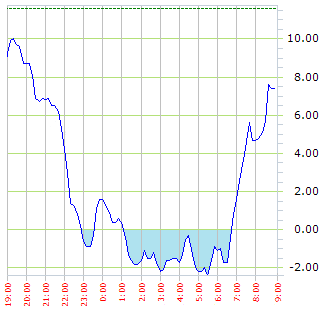





|
Sun Mon Tue Wed Thu Fri Sat
1 2 3 4
5 6 7 8 9 10 11
12 13 14 15 16 17 18
19 20 21 22 23 24 25
26 27 28 29 30 31
|
1: 12.500048
2: 18.750062 6.250013
4: 25.170949 6.420888 1.027340
8: 31.693743 6.522794 1.015871
16: 37.909443 6.215700 0.952920 163.717658
32: 43.669983 5.760540 0.926773 116.575916
64: 48.941909 5.271926 0.915179 105.823609
128: 53.739774 4.797865 0.910078 102.297909
256: 58.094627 4.354853 0.907665 100.903254
512: 62.042770 3.948143 0.906608 100.369371
1024: 65.620563 3.577793 0.906196 100.184122
2048: 68.862056 3.241493 0.906003 100.105789
4096: 71.797179 2.935123 0.905485 99.916672
8192: 74.455626 2.658447 0.905736 99.999355
16384: 76.863716 2.408090 0.905826 100.026223
32768: 79.045333 2.181617 0.905953 100.060856
65536: 81.019926 1.974593 0.905105 99.853568
The second program calculates squares of size thousand and then glues these together into a larger square. The program counts all the closed loops into this larger square, all the open loops that start from the edge, and the number of loops when the larger square would tile infinitely in all directions. Below the results for the larger square of size 2,392,000.
closed loops
1: 12.493719 12.493719
2: 18.743736 6.250017 0.500253 25.000074
4: 25.164570 6.420834 1.027331
8: 31.687396 6.522826 1.015885
16: 37.903001 6.215604 0.952900 163.654905
32: 43.663582 5.760582 0.926793 116.592477
64: 48.935576 5.271994 0.915184 105.821788
128: 53.732895 4.797319 0.909963 102.217151
256: 58.087519 4.354624 0.907720 100.922381
512: 62.035303 3.947784 0.906573 100.342748
1024: 65.612240 3.576937 0.906062 100.112939
2048: 68.852944 3.240704 0.906000 100.087675
4096: 71.787913 2.934969 0.905658 99.962758
8192: 74.446751 2.658838 0.905917 100.048465
16384: 76.855399 2.408648 0.905902 100.044104
32768: 79.036567 2.181169 0.905557 99.950543
65536: 81.011179 1.974612 0.905300 99.887785
131072: 82.798137 1.786958 0.904967 99.814658
262144: 84.412389 1.614252 0.903352 99.500573
524288: 85.869983 1.457593 0.902953 99.431783
1048576: 87.195275 1.325293 0.909234 100.471130
2097152: 88.389223 1.193947 0.900893 99.242344
4194304: 89.478741 1.089518 0.912534 100.845767
8388608: 90.462942 0.984202 0.903337 99.660479
16777216: 91.354342 0.891400 0.905708 99.916601
33554432: 92.162496 0.808154 0.906612 100.008094
67108864: 92.859149 0.696653 0.862030 97.211789
134217728: 93.533627 0.674478 0.968170 114.049322
268435456: 94.082341 0.548714 0.813539 96.476405
536870912: 94.592299 0.509957 0.929368 101.302246
1073741824: 95.112775 0.520476 1.020627
2147483648: 95.357816 0.245041 0.470801 95.575816
4294967296: 95.357816 0.000000 0.000000 95.357816
8589934592: 95.534888 0.177072
open loops
1: 0.000042
2: 0.000042 0.000000
4: 0.000081 0.000039
8: 0.000133 0.000052 1.315765
16: 0.000205 0.000072 1.402178
32: 0.000304 0.000099 1.371537
64: 0.000438 0.000133 1.344078
128: 0.000617 0.000180 1.348334
256: 0.000861 0.000244 1.355238
512: 0.001188 0.000326 1.338883
1024: 0.001625 0.000437 1.339179
2048: 0.002213 0.000588 1.345623
4096: 0.003003 0.000790 1.344026
8192: 0.004066 0.001063 1.344681
16384: 0.005509 0.001443 1.357898
32768: 0.007415 0.001906 1.320786
65536: 0.010008 0.002593 1.360525
131072: 0.013572 0.003564 1.374276
262144: 0.018348 0.004776 1.340206
524288: 0.024735 0.006387 1.337181
1048576: 0.033401 0.008666 1.356814
2097152: 0.045087 0.011686 1.348511
4194304: 0.060032 0.014945 1.278923
8388608: 0.079870 0.019838 1.327387
16777216: 0.107546 0.027676 1.395115
33554432: 0.153510 0.045964 1.660766
67108864: 0.201192 0.047681 1.037357
134217728: 0.269990 0.068798 1.442885
268435456: 0.355750 0.085760 1.246539
536870912: 0.452635 0.096885 1.129728
1073741824: 0.597440 0.144805 1.494598
2147483648: 0.781714 0.184274 1.272567
4294967296: 1.153069 0.371356 2.015240
8589934592: 1.385508 0.232438 0.625918
17179869184: 2.017776 0.632269 2.720159
34359738368: 2.844043 0.826267 1.306828
68719476736: 4.458862 1.614819 1.954355
tiles
1: 12.493730 12.493730
2: 18.743757 6.250027 0.500253 25.000116
4: 25.164607 6.420850 1.027331
8: 31.687457 6.522850 1.015886
16: 37.903095 6.215639 0.952902 163.660648
32: 43.663725 5.760630 0.926796 116.596031
64: 48.935785 5.272060 0.915188 105.825537
128: 53.733195 4.797410 0.909969 102.221851
256: 58.087941 4.354746 0.907729 100.928208
512: 62.035889 3.947948 0.906585 100.350432
1024: 65.613054 3.577165 0.906082 100.124076
2048: 68.854062 3.241009 0.906027 100.101847
4096: 71.789431 2.935368 0.905696 99.980717
8192: 74.448820 2.659389 0.905981 100.075166
16384: 76.858192 2.409373 0.905987 100.076992
32768: 79.040359 2.182166 0.905699 99.998619
65536: 81.016282 1.975923 0.905487 99.946752
131072: 82.805034 1.788752 0.905274 99.899664
262144: 84.421823 1.616789 0.903865 99.622882
524288: 85.883016 1.461193 0.903762 99.604916
1048576: 87.212994 1.329977 0.910200 100.693450
2097152: 88.413218 1.200225 0.902440 99.515405
4194304: 89.509560 1.096342 0.913447 101.080002
8388608: 90.506534 0.996974 0.909364 100.509278
16777216: 91.413404 0.906870 0.909623 100.540794
33554432: 92.238358 0.824953 0.909671 100.546177
67108864: 92.958148 0.719790 0.872522 97.884741
134217728: 93.678066 0.719919 1.000179
268435456: 94.288153 0.610086 0.847438 97.676997
536870912: 94.874533 0.586380 0.961143 109.378884
1073741824: 95.496884 0.622352 1.061345
2147483648: 95.965885 0.469001 0.753595 97.400257
4294967296: 95.965885 0.000000 0.000000 95.965885
8589934592: 96.402051 0.436165
17179869184: 96.935889 0.533838 1.223936
34359738368: 96.935889 0.000000 0.000000 96.935889
68719476736: 96.935889 0.000000
137438953472: 99.993750 3.057861
Of course it is not possible to make any definite statements based on these statistics, I think it is safe to conclude that the number of infinite paths is low, below 5% and possibly even much lower. It is not unlikely that the chance of hitting a infinite path approaches zero. It is not difficult to create a tiled infinite diagonal maze with infinite paths, but that still could mean that they are very rare in a fully random infinite maze.
 Saturday, May 11, 2013
Saturday, May 11, 2013
I decided to use the program I developed before, to see if there were any solutions. Here is the least connected solution found by the program:
All the 79 solutions (with only the solved part showing) found by the program are:
Then I got the idea for looking for all the solutions in eight by ten square. Below the collection of unique solutions (taken into account mirroring) is given. One would expect every unique solution to occur exact four times, but this is not the case. This could possibly hint at some error in the algorithm used, meaning that there could be more solutions.
 Friday, May 24, 2013
Friday, May 24, 2013gen_CWP 8 10 wozg | gen_dpfp -n | CWP 8 10 5 | SCWP 8 10 wozg | sort -uI had not expected that it would find any solution, but to my surprise it did find seven solutions, of two pairs are kind of similar, because all the green pieces are stacked in a column: